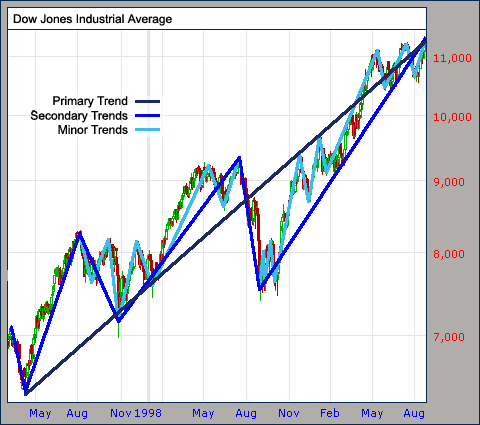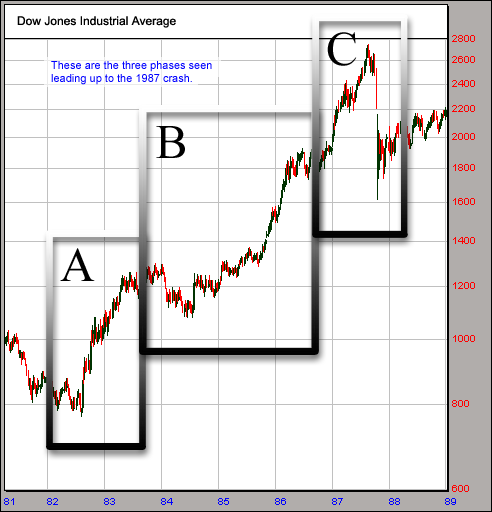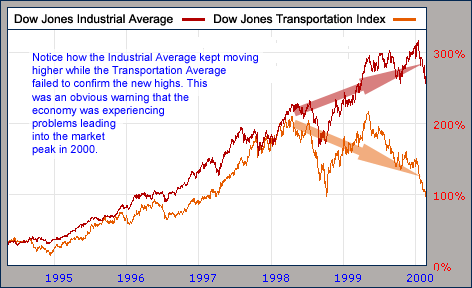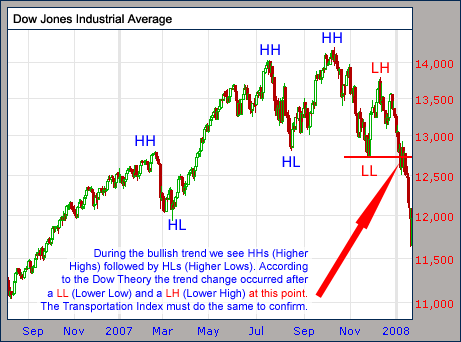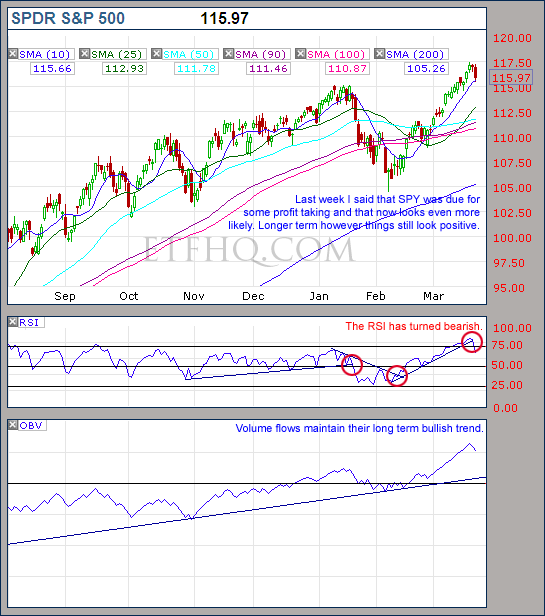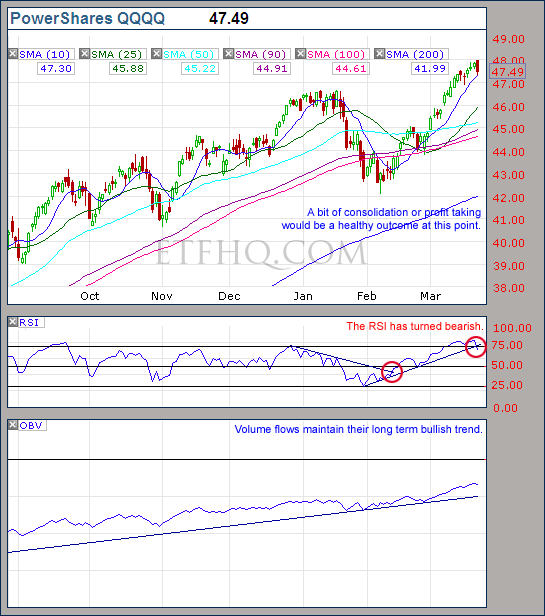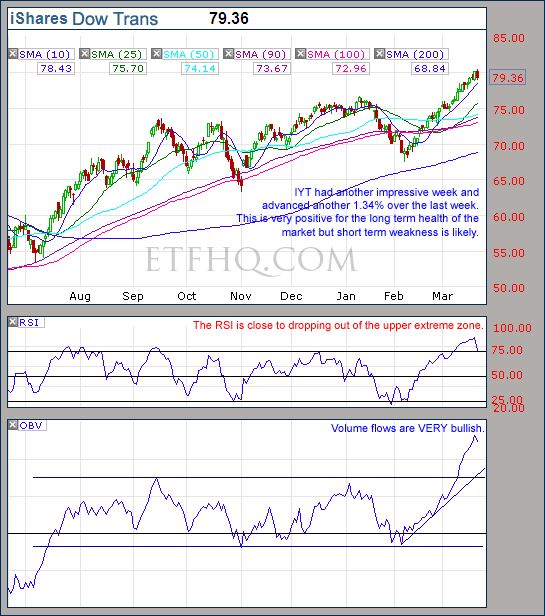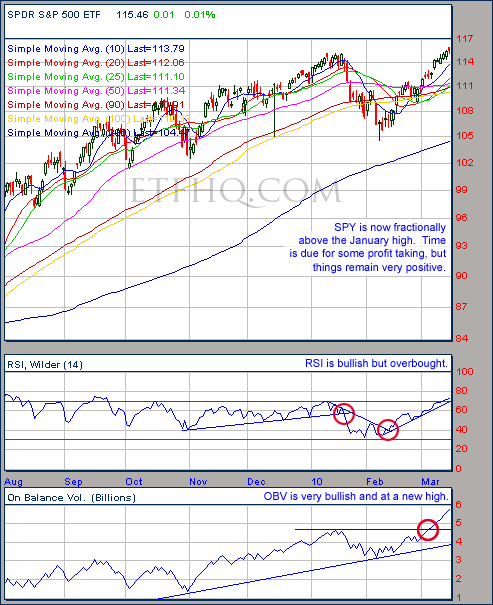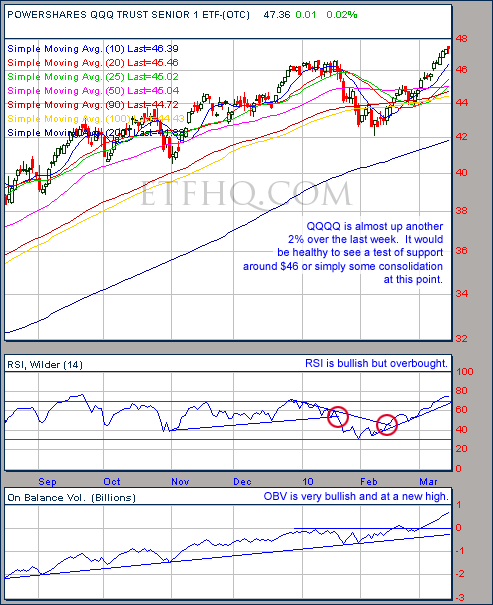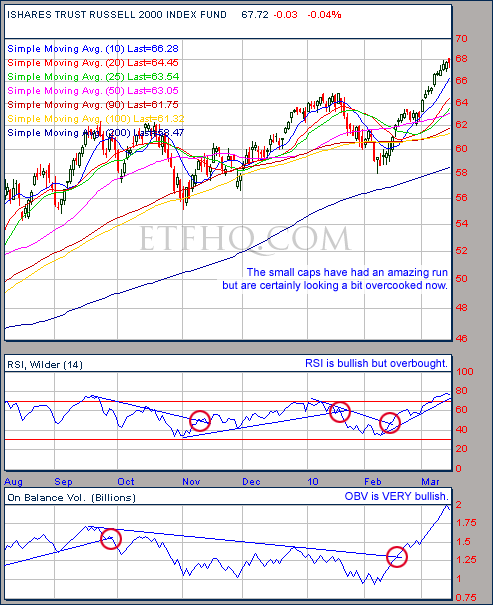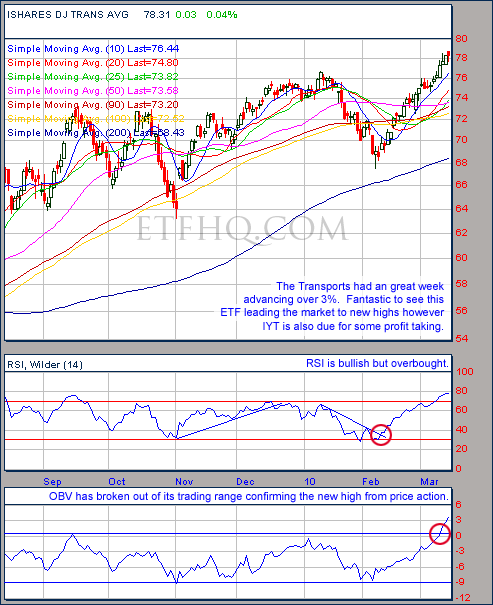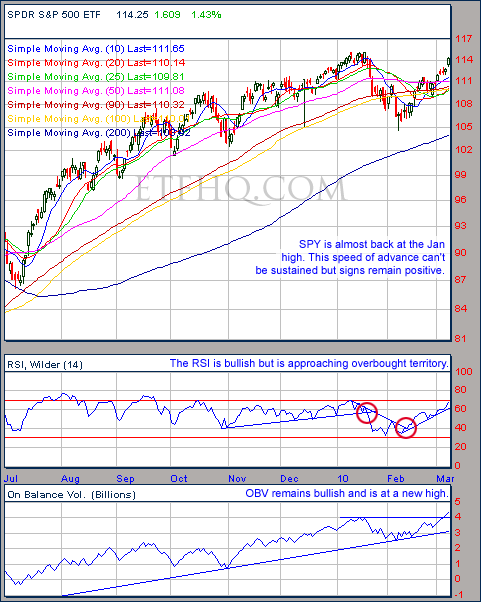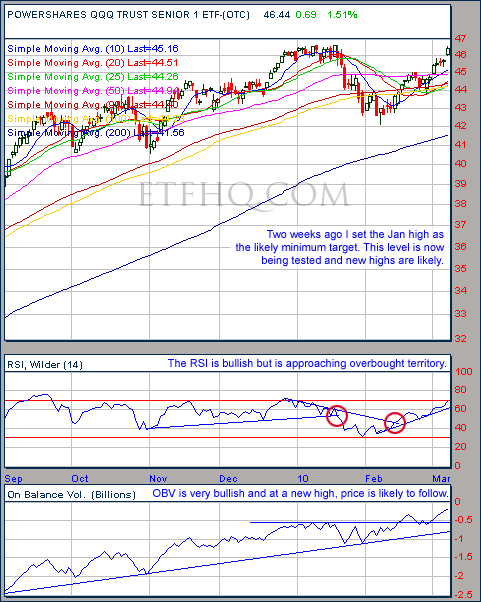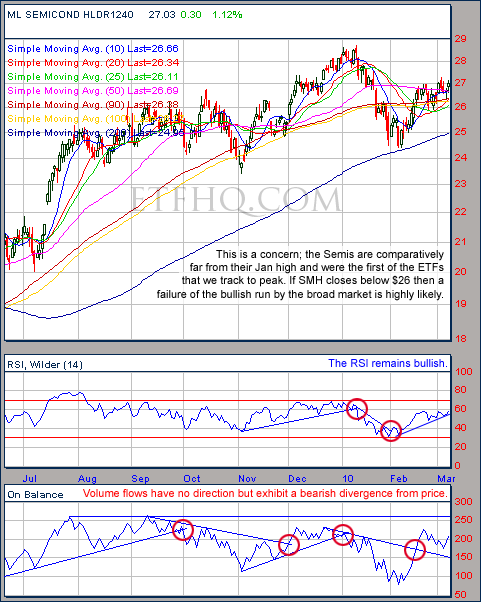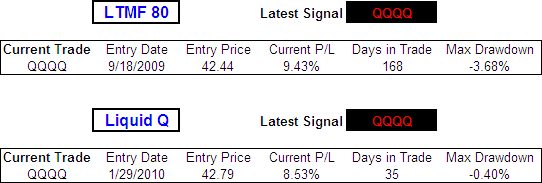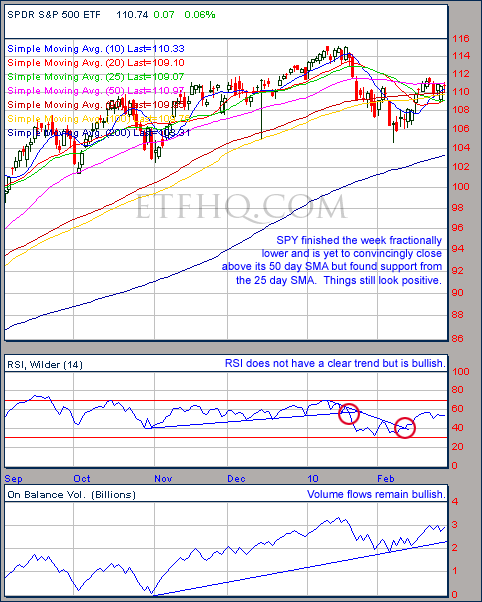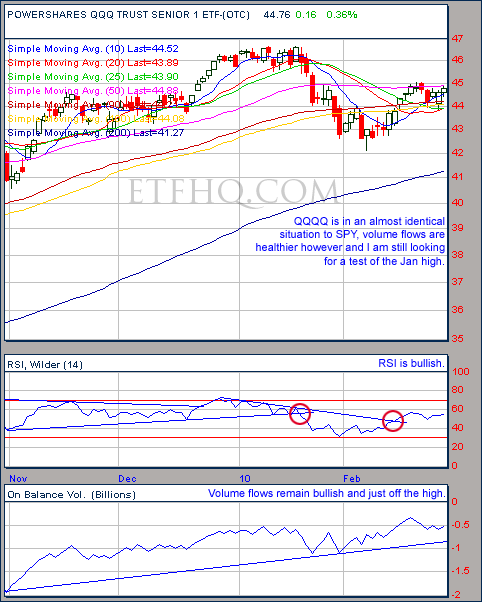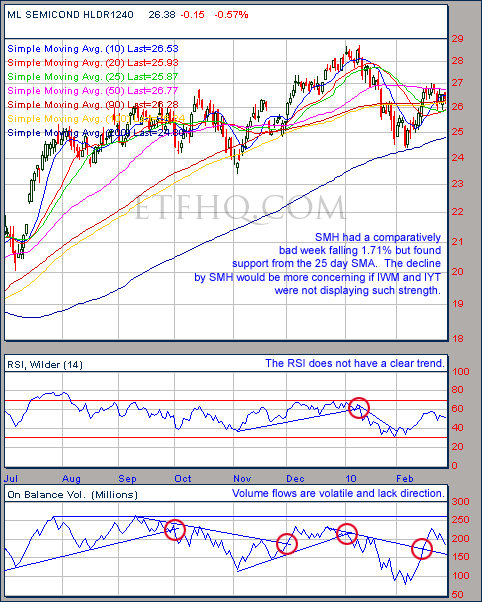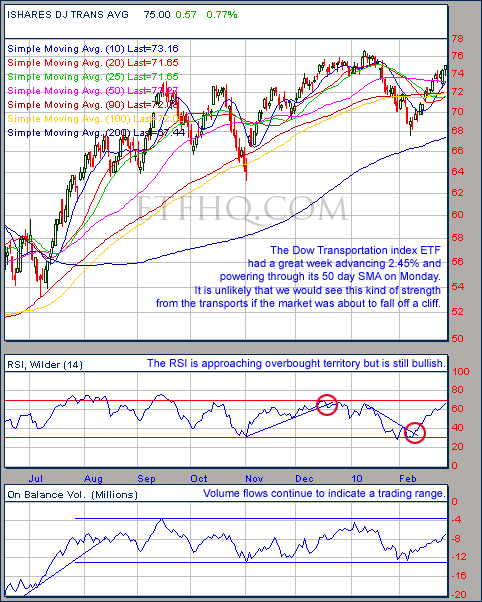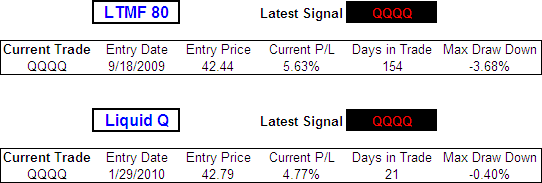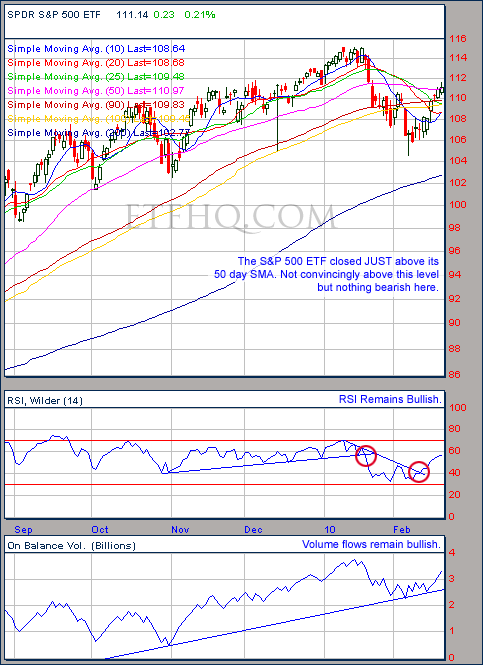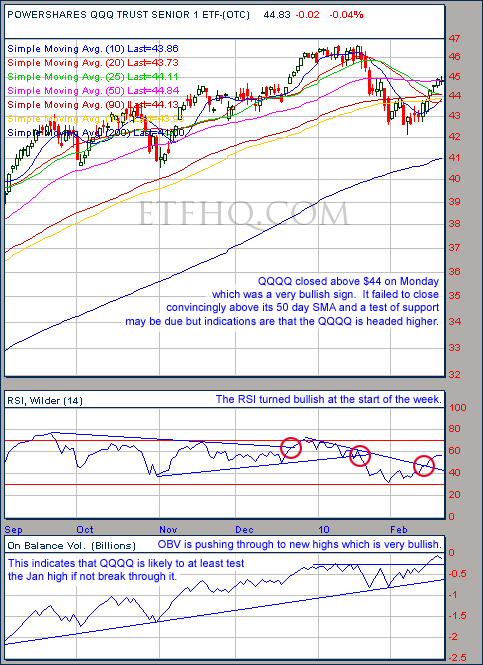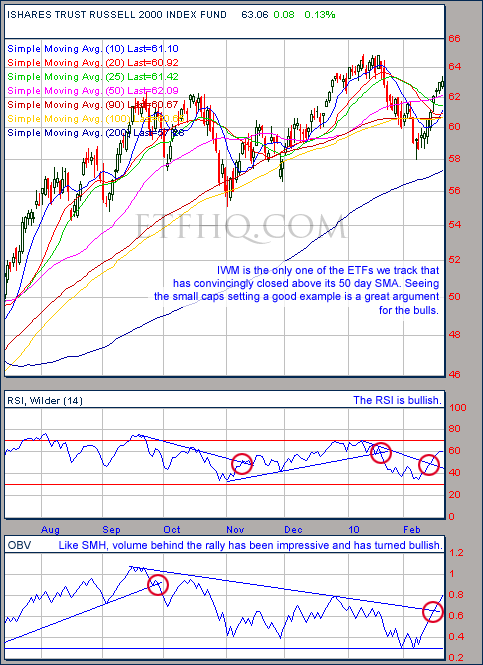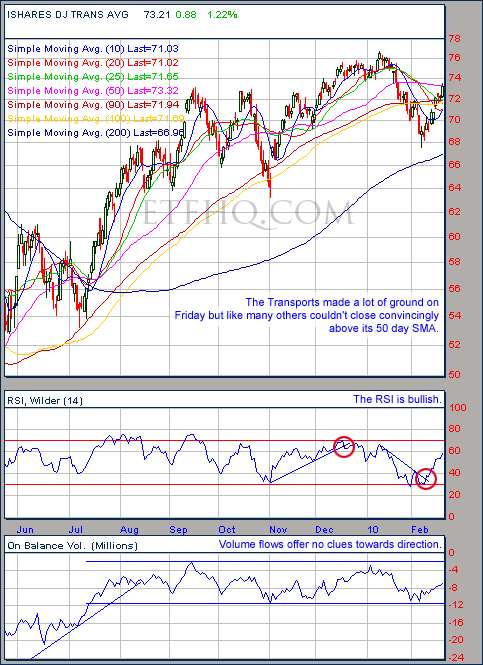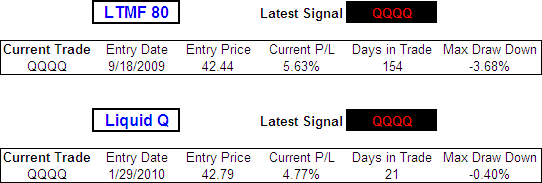April 19, 2010 – 12:05 pm ET
Dear Investor,
Sorry, we are running late today due to a data feed problem but all is back up and running now (touch wood). Living at this end of the world that means staying up all night… you are welcome 😉
Over the last week there were some very interesting developments:
The first one was Intel reporting its net income in the first quarter had nearly quadrupled from 2009 and that the big jump in spending had predominantly come from companies, not individuals. When businesses are experiencing improved conditions and anticipating growth they must invest in new technology to capitalize on it. This investment takes time to produce a return but because semiconductors are at the front of the business cycle they are the first ones to benefit. That is why the news not only lifted Intel (INTC) but gave the entire market a significant boost. If you have ever doubted the influence that semiconductors have over the market then doubt no more.
The 2nd major development was Goldman Sachs getting charged with fraud. The SEC alleges that Goldman marketed CDOs that hinged on the performance of subprime mortgage-backed securities and failed to disclose to investors that hedge fund Paulson & Co. was betting against the same CDOs and influenced the selection of securities for the portfolio. While this does sound morally questionable is it really fraud?
Lets say I ran a hedge fund and was bearish on the Passion Fruit Industry. I could go out and help an institution put together a security for me to sell short. If my research and timing was correct then I would profit but there is also the risk of being wrong in which case I would take a loss. The institution what helped create the security is simply making a market, finding buyers and sellers. The opinion of those who influenced the portfolio selection is irrelevant because if investors do their own research and don’t like a security then surely they won’t risk their money in it? When Warren Buffett sold 4.5 billion dollars worth of put options should the buyers have been informed who the counterparty was?
If anyone committed fraud then what about the rating agencies? The CDOs in question were class A-1 notes rated AAA by S&P and Aaa by Moody. Let me know what you think. Assuming the allegations are true did Goldman commit fraud or is this just an example of the heartless reality of capitalism?
.
ETF % Change Comparison
.

Last week I warned that “When risk levels are perceived to be low the market is more easily spooked and this tends to lead to sharper and more severe reversals.” Most of the gains for the week were on the back of the INTC news while on Friday the SEC charge spooked a complacent and overbought market causing it to sell off heavily as you can see by the ‘% from peak’ numbers.
What is great to see is that for the week SPY and DIA lagged behind while SMH and ITY advanced 5.85% and 3.22% respectively. This is not the type of behavior that you tend to see at major market reversals. This is how a bull market behaves.
.
What the % Comparison Table Tells Us:
By comparing the performance of the economically sensitive (SMH, QQQQ, IWM, IYT) and the comparatively stable ETFs (SPY and DIA) we can get an indication of the true market direction. The more sensitive areas of the market tend to be the first to initiate a trend change. For example if DIA and SPY sell off heavily while SMH and IWM (Russell 2000 small cap ETF) sell of mildly or continue moving to new highs then this would be very positive and vice versa.
The ‘Average Rank %’ is calculated by subtracting the % change for each ETF from the maximum % change and dividing it by the range for each period. 1-((MAX(% change all ETFs)-ETFs % Change)/(MAX(% change all ETFs)-MIN(% change all ETFs))) The readings for each period are then averaged. This reading is provided because if one ETF was significantly under/out performing the others then a plain high or low rank would not accurately reflect this.
.
![]()
.
A Look at the Charts
.
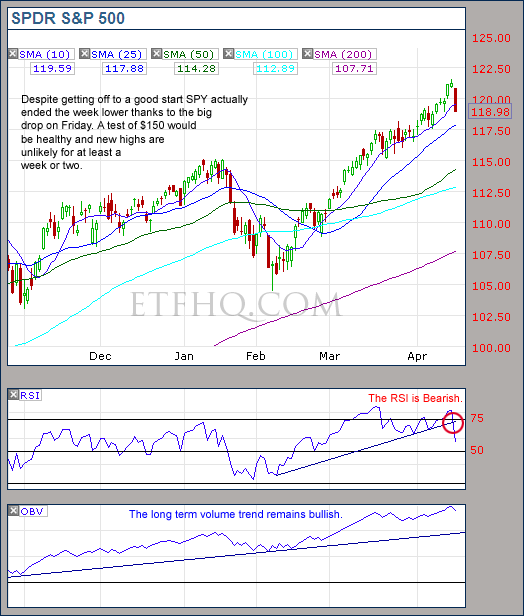
SPY actually dropped 1.59% on Friday and further profit taking over the short term is likely.
.
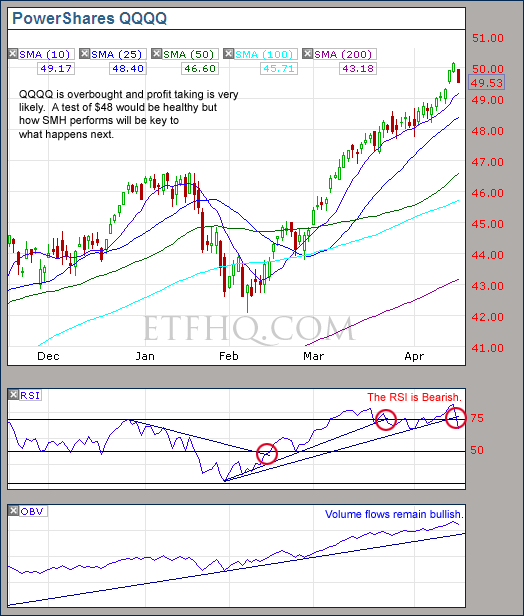
It won’t actually take much for QQQQ to break its bullish volume trend. But if that happens then it will need to be confirmed by a loss of support and failure in other areas of the market particularly the semiconductors.
.
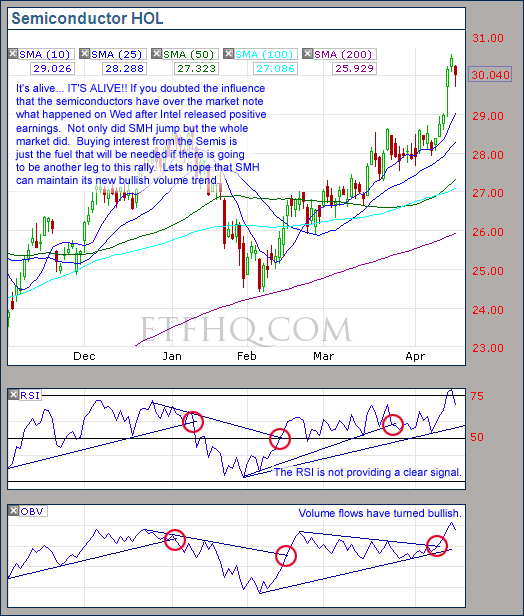
For months SMH has been one of the holes in the long term bullish argument but suddenly it is showing life again. If we see profit taking over the next few weeks but SMH can hold onto $29 and maintain its bullish volume trend this will indicate the market is very strong.
.

What goes up must come down and profit taking on the small caps is highly likely.
.
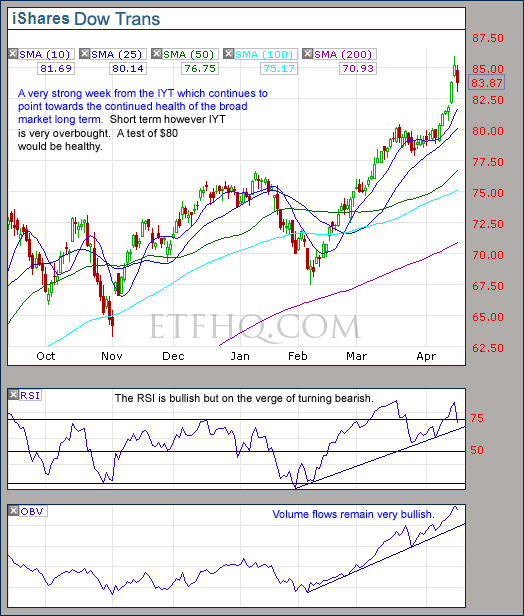
The transports continue to receive impressive volume, a very good sign long term.
.
![]()
.
OM3 Weekly Indicator
.

No signs of weakness here.
.
How to read the OM3 indicator
The OM3 indicator as with most of our models primarily reads price action and volume. The strong/weak buy/sell signals are self-explanatory. ‘No Signal’ means that the component readings are in conflict and cancel each other out.
The alerts let you know if the cycle is speeding up or slowing down, so when you get at ‘Strong Buy, Bear Alert’ for instance it simply means that the criteria for a strong buy is in place but this weeks cycle reading is weaker (or more bearish) than last weeks reading (the same is true in reverse).
The number of weeks that a signal has been repeated is displayed. Historically a ‘Strong Buy’ signal has lasted for an average of 6 weeks and a maximum of 42 weeks, while a ‘Strong Sell’ has lasted for an average of 4 weeks and a maximum of 16.
This is an indicator not a mechanical trading model. It is useful to assist in analyzing the market but for the best results should be combined with commonsense and support/resistance levels etc.
.
![]()
.
TransDow & NasDow
.

The Transports remains dominant over the Dow and have doubled the Dow’s return over the last 49 days with 12.36% vz 6.72%.
.
What the TransDow Readings tell us:
The TransDow measures dominance between the DJ Transportation Index (DJTI) and the Dow Jones Industrial Average (DJIA). In a strong market the more economically sensitive Transportation Index should be dominant over the DJIA.
Historically the DJTI has been dominant over the Dow 45% of the time. The annualized rate of return from the DJTI during this period was 18.47% with the biggest loss for one trade sitting at -13.27%. The annualized return from the DJIA during the periods it was dominant over the DJTI was just 4.06% and the biggest loss for one trade was -16.13%. A 4% stop-loss is applied to all trades adjusting positions only at the end of the week.
What the NasDow Readings tell us:
The NasDow measures dominance between the NASDAQ and the DJIA. Using the same theory behind the Trans Dow; in a strong market the more economically sensitive NASDAQ should be dominant over the DJIA.
Historically the NASDAQ has been dominant over the DJIA 44% of the time. Taking only the trades when the NASDAQ is above its 40 week moving average the annualized rate of return was 25.47% with the biggest loss for one trade sitting at –8.59%. The annualized rate on the DJIA during the periods it was dominant over the NASDAQ is just 8.88% and the biggest loss for one trade was –12.28%. A 8% stop-loss is applied to all trades adjusting positions only at the end of the week.
.
![]()
.
LTMF 80 & Liquid Q
.
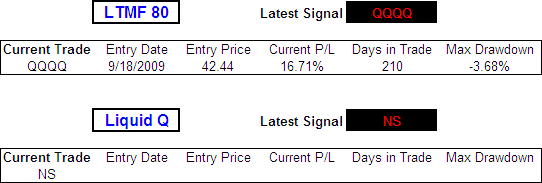
The LTMF 80 remains on a buy signal for QQQQ after 210 days. Liquid Q has no signal.
.
Historical Stats:
.

.
How The LTMF 80 Works
LTMF stands for Long Term Market Forecaster. It reads volume flows relative to price action and looks for out performance of volume measured on a percentage basis over the prior 12 months. During a sustained rally the readings will reach high levels (near 100%) making it imposable for the volume reading to always outperform price so any reading above 80% will maintain the buy signal. This system has outperformed the market over the last 10 years but performance has been damaged by some nasty losses. It only produces buy signals and only for QQQQ.
How Liquid Q Works
Liquid Q completely ignores price action and instead measures the relative flow of money between a selection of economically sensitive and comparatively stable ares of the market. It looks for times when the smart money is confident and and can be seen by through volume investing heavily is more risky areas due to an expectation of expansion. This system has outperformed the market over the last 10 years and remained in cash through most of the major declines. It only produces buy signals and only for QQQQ. We will provide more performance details on the web site for these systems soon.
.
![]()
.
Summary
.
New strength seen from the semiconductors is very bullish and long term indications remain positive. However over the short term I would be very surprised to see new highs and tangible profit taking is highly likely.
.
Any disputes, questions, queries, comments or theories are most welcome in the comments section below.
.
Derry
And the Team @ ETF HQ
“Equipping you to win on Wall St so that you can reach your financial goals.”
.
P.S Thanks to the 20 people who shared our article on Herd Mentality around Facebook
P.P.S Become a fan of ETFHQ on Facebook – HERE
.
![]()
.
Breaking NEWS
Bank Run in Switzerland
.
The bank run in Switzerland last week was kept mostly secret from the worlds media but this exclusive footage was captured from my brother in-laws iPhone. Some are saying that it was actually very bullish behavior – VIDEO

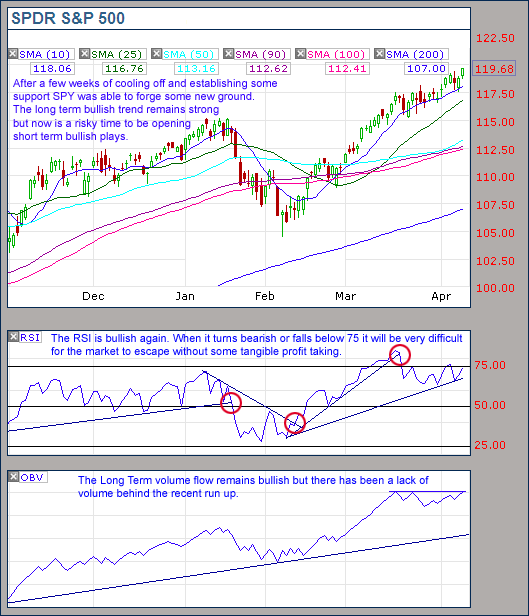

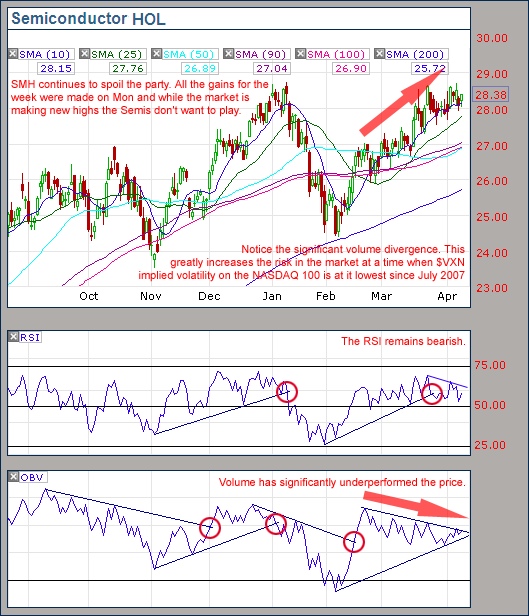
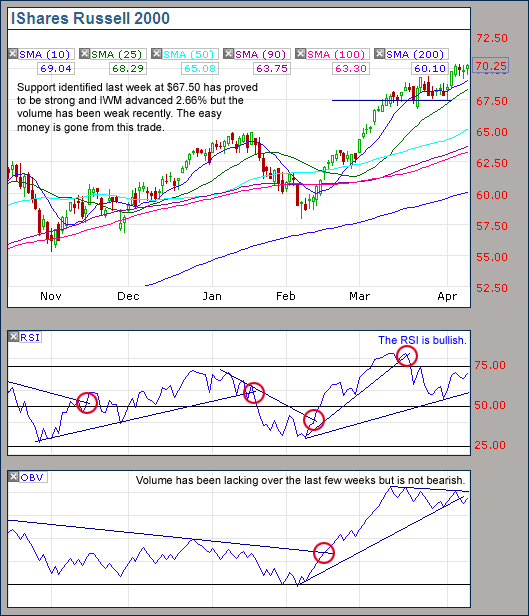
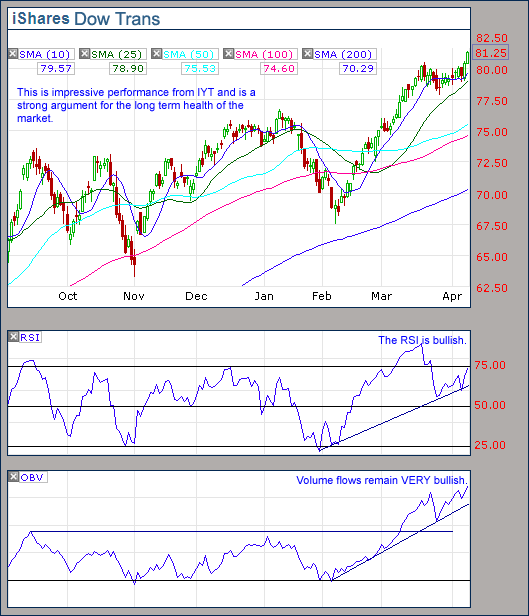


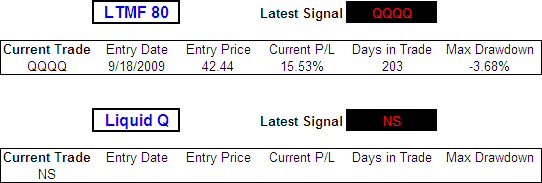

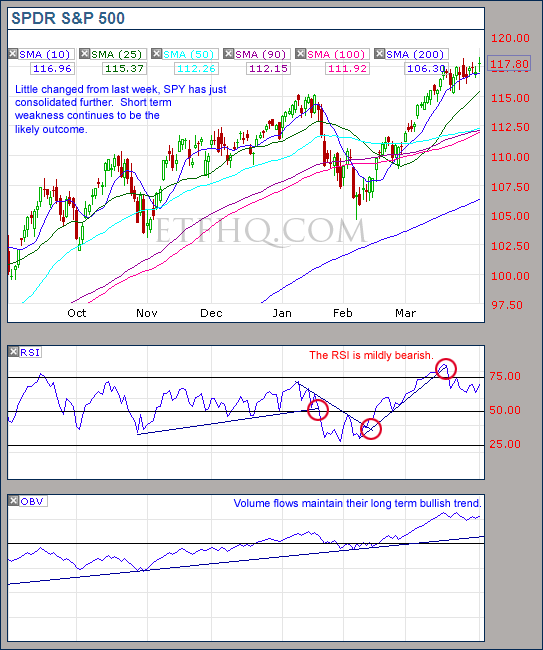

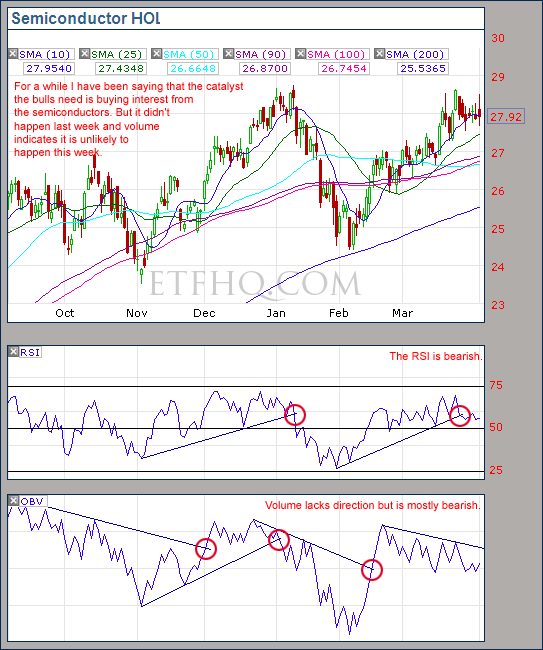
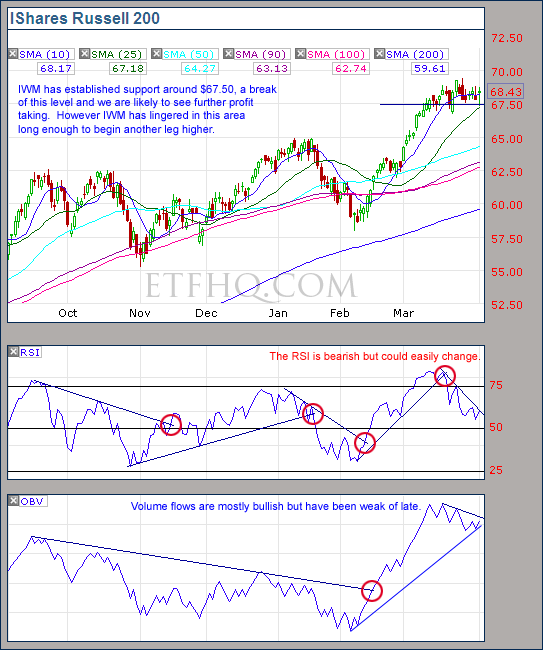
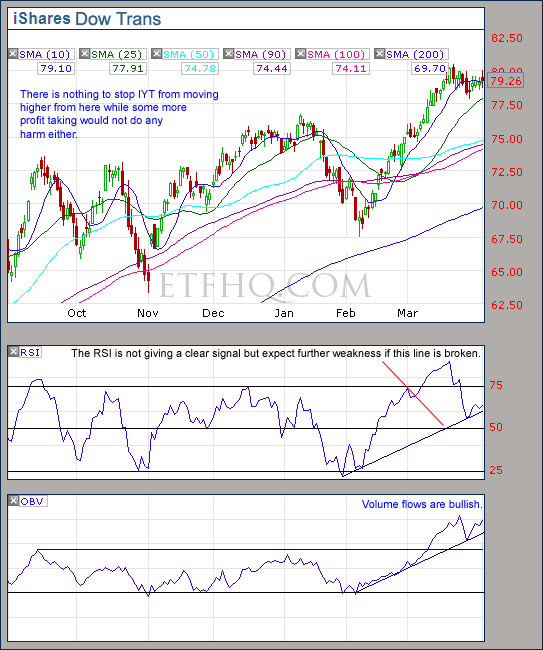




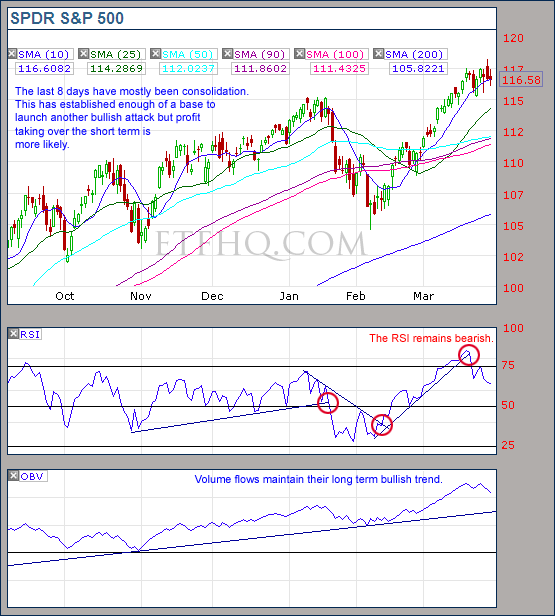
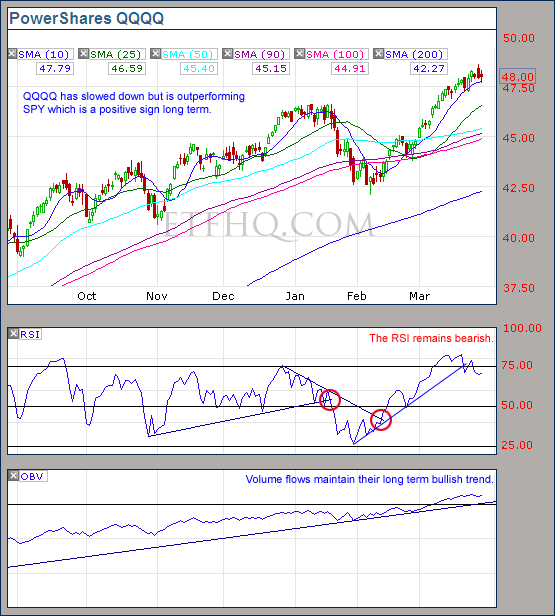

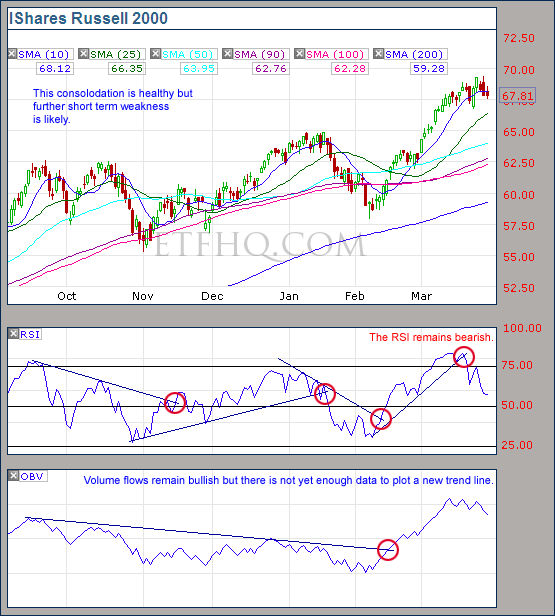



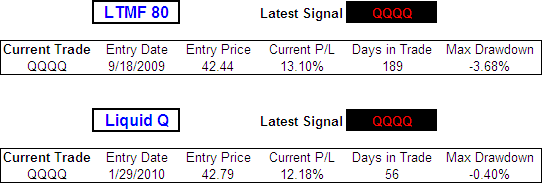
 There are very few writings on technical analysis that have stood the test of time and truly deserve respect but the Dow Theory is unquestionably one of them.
There are very few writings on technical analysis that have stood the test of time and truly deserve respect but the Dow Theory is unquestionably one of them.